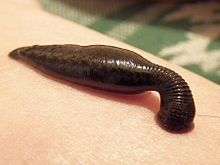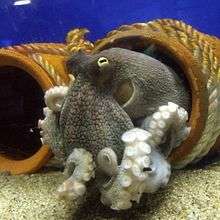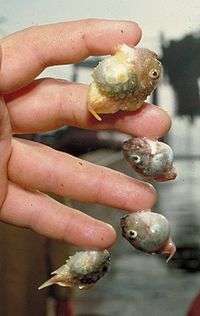Sucker (zoology)
A sucker in zoology refers to specialised attachment organ of an animal. It acts as an adhesion device in parasitic worms, several flatworms, cephalopods, certain fishes, amphibians, and bats. It is a muscular structure for suction on a host or substrate. In parasitic annelids, flatworms and roundworms, suckers are the organs of attachment to the host tissues. In tapeworms and flukes, they are a parasitic adaptation for attachment on the internal tissues of the host, such as intestines and blood vessels.[1] In roundworms and flatworms they serve as attachment between individuals particularly during mating. In annelids, a sucker can be both a functional mouth and a locomotory organ.[2] The structure and number of suckers are often used as basic taxonomic diagnosis between different species, since they are unique in each species. In tapeworms there are two distinct classes of suckers, namely "bothridia" for true suckers, and "bothria" for false suckers. In digeneal flukes there are usually an oral sucker at the mouth and a ventral sucker (or acetabulum) posterior to the mouth. Roundworms have their sucker just in front of the anus; hence it is often called a pre-anal sucker.

Among chordates, some fishes and mammals have suckers, which are used as a holdfast to substrata. Among fishes some members of the order Perciformes have modified fins that form a sucker. Some bats, the Madagascar and the Western sucker-footed bat have unusual suckers on their limbs that are useful during roosting. Some amphibians such as the frog have adhesive pads on their toes to help with their locomotion.
In helminths
Turbellaria
In the class Turbellaria, only the species of the order Temnocephalida are parasitic and possess an adhesive disc. The sucker is present at the posterior end on the ventral side.[3] It is lined with syncytial epidermis and numerous microvilli. Beneath the apical membrane are many vacuoles and dense bodies. It is attached to the body through a short stalk. Densely packed muscle fibres link the sucker with the main body through the stalk.[4]
Udonellidae
Udonellids are symbiotic to fishes, on which body they remain attached using a sucker. The sucker is a membranous extension of the posterior end. It has an indistinct stalk and the anterior surface is lined with microvilli. Some portion of the tegument has interconnected surface extension appearing as loops. The interior is divided into several compartments which are surrounded by interconnected connective tissue. The connective tissues are linked with muscles that extend into the main body.[4]
Tapeworms
In tapeworms, the sucker is called bothridium (plural "bothridia")[5] to differentiate it from the sucker-like protrusion called bothrium in some species.[1]
Flukes
Among the flukes belonging to class Digenea, there are two suckers, namely an oral sucker and a ventral sucker (often called acetabulum).[7] The oral sucker is at the tip of the anterior body and directly surrounds the mouth. The ventral sucker is located halfway to the middle of the body on the ventral side. They are both used for attachment to intestinal wall and blood vessels. The detailed structure of the suckers, presence or absence of hooks, and their exact position on the body are major taxonnomic keys between species.[8]
In the class Monogenea, buccal organs, also known as buccal suckers, are present in worm parasites of the order Mazocraeidea. They are known to have muscular, glandular, and sensory components thought to play some role in blood feeding. In other species like Anoplodiscus, the sucker is a posterior extension, connected to the main body through a small stalk. The surface is profusely covered with microvilli. It is used for symbiotic association with fishes.[4]
Nematodes
Parasitic roundworms such as species of Ascaridia and Heterakis possess a single sucker at the posterior end of the body, just in front of anus, hence is often called a pre-anal sucker. Only the male roundworms have them, and are used for attachment to female during mating. The sucker is a protruding cuticle and circular in shape.[9][10]
In annelids

Annelid worms such as leeches all have an anterior (oral) sucker formed from the first six segments of their body, which is used to connect to a host for feeding. It also releases an anaesthetic to prevent the host from feeling pain while it sucks blood. They use a combination of mucus and suction (caused by concentric muscles in those six segments) to stay attached and secrete an anti-clotting enzyme, hirudin, into the host's blood stream. The medicinal leech (Hirudo medicinalis) has two suckers, one at each end, called the anterior and posterior sucker. The posterior is mainly used for leverage while the anterior sucker, consisting of the jaw and teeth, is where the feeding takes place.[11] During locomotion directional movement of the body is done by successive attachment and detachment of the oral sucker and the acetabulum.[2]
Mollusca

Cepaholopods are characterised by elongated appendages for locomotion and grasping object. There are two main types: arms, such as in octopus, bearing numerous suckers along its ventral surface; and tentacles, such as in squid and cuttlefish, having a single sucker at the tip.[12] Each sucker is a circular and bowl-like curved disc. It in turn has two distinct parts: an outer shallow cavity called infundibulum and a central hollow cavity called acetabulum. Both these structures are thick muscles, and are covered with chitinous cuticle to make a protective surface.[13] It is used for grasping substratum, catching prey and for locomotory accessory. When the sucker attaches itself on an object, the infundibulum maily provides adhesion while the central acetabulum is quite free. The sequential muscle contraction the infundibulum and acetabulum causes attachment and detachment.[14][15]
In fish

Gobies, remoras and lumpsuckers have suckers which are modified fins. These fishes use their suckers to cling to substrata or to bigger fishes. In gobies the disc-shaped sucker is formed from fused pelvic fins. Amphidromous gobies particularly use their suckers for climbing through waterfalls during their developmental migrations.[16][17] In remoras the sucker is a modified dorsal fin. In lumpsuckers, also known as lumpfish, the sucker is formed from modified pelvic fins, located ventrally, and behind the pectoral fins.
A fish family the Catostomidae are known as suckers. These fish have a suckermouth.
In bats
Certain species of bats such as Madagascar sucker-footed bat and Western sucker-footed bat, are generally called "sucker-footed bats" because of suckers on their limbs. They are members of the family Myzopodidae and endemic to Madagascar. They have small cups of suckers on their wrists and ankles. They roost inside the rolled leaves of palm trees, using their suckers to attach themselves to the smooth surface.[18][19]
References
- Castro GA (1996). "Helminths: Structure, Classification, Growth, and Development". In Baron S (ed.). Medical Microbiology (4 ed.). Galveston (TX): University of Texas Medical Branch at Galveston. ISBN 978-0-9631172-1-2. PMID 21413252.
- Stern-Tomlinson W, Nusbaum MP, Perez LE, Kristan WB Jr (1986). "A kinematic study of crawling behavior in the leech, Hirudo medicinalis". J Comp Physiol A. 158 (4): 593–603. doi:10.1007/bf00603803. PMID 3723440.
- Hosie, Andrew. "Friendly Flatworms: The Temnocephalida". Government of Western Australia. Retrieved 14 February 2014.
- Rohde, K.; Watson, N. A. (1995). "Comparative ultrastructural study of the posterior suckers of four species of symbiotic Platyhelminthes, Temnocephala sp, Udonella caligorum, Anoplodiscus cirrusspiralis, and Philophthalmus sp" (PDF). Folia Parasitologica. 42 (1): 11–28.
- Bothridium on www.merriam-webster.com
- Bray, RA.; Justine, J-L. (2014). "A review of the Zoogonidae (Digenea: Microphalloidea) from fishes of the waters around New Caledonia, with the description of Overstreetia cribbi n. sp". PeerJ. 2: e292. doi:10.7717/peerj.292. PMC 3961169. PMID 24688868.
- Neuhaus, Walter (1985). "Die Arbeitsweise des Bauchsaugnapfes digenetischer Trematoden am Beispiel desDicrocoelium dendriticum". Zeitschrift für Parasitenkunde. 71 (1): 53–60. doi:10.1007/BF00932918. PMID 3984451.
- Baker, David G. (2008). Flynn's Parasites of Laboratory Animals (2nd ed.). Hoboken: John Wiley & Sons. pp. 31, 138. ISBN 9780470344170.
- "Heterakis gallinae". Bioinformatics Centre, North-Eastern Hill University. Retrieved 14 February 2014.
- Park, Sang-Ik; Shin, Sung-Shik (2010). "Concurrent Capillaria and Heterakis Infections in Zoo Rock Partridges, Alectoris graeca". The Korean Journal of Parasitology. 48 (3): 253–7. doi:10.3347/kjp.2010.48.3.253. PMC 2945802. PMID 20877506.
- Farnesi RM, Marinelli M, Tei S, Vagnetti D (1981). "Morphological and ultrastructural aspects of Branchiobdella pentodonta Whit. (Annelida, Oligochaeta) suckers". J Morphol. 170 (2): 195–205. doi:10.1002/jmor.1051700206. PMID 7299828.
- Boumis R (2013). "Animals With Tentacles". Pawnation. AOL Inc. Retrieved 2013-06-08.
- Walla G (2007). "A study of the Comparative Morphology of Cephalopod Armature". tonmo.com. Deep Intuition, LLC. Retrieved 2013-06-08.
- Kier WM, Smith AM (2002). "The structure and adhesive mechanism of octopus suckers". Integr Comp Biol. 42 (6): 1146–1153. doi:10.1093/icb/42.6.1146. PMID 21680399.
- Octopuses & Relatives. "Learn about octopuses & relatives: locomotion". asnailsodyssey.com. Retrieved 2013-06-08.
- Maie, T.; Schoenfuss, H. L.; Blob, R. W. (2012). "Performance and scaling of a novel locomotor structure: adhesive capacity of climbing gobiid fishes". Journal of Experimental Biology. 215 (22): 3925–3936. doi:10.1242/jeb.072967. PMID 23100486.
- Knight, K. (2012). "Climbing gobies have small but powerful suckers". Journal of Experimental Biology. 215 (22): ii. doi:10.1242/jeb.081273. PMID 23256209.
- Macdonald, D., ed. (1984). The Encyclopedia of Mammals. New York: Facts on File. pp. 807. ISBN 978-0-87196-871-5.
- Brown University News, December 2009, Bats Don’t Use Suction After All
